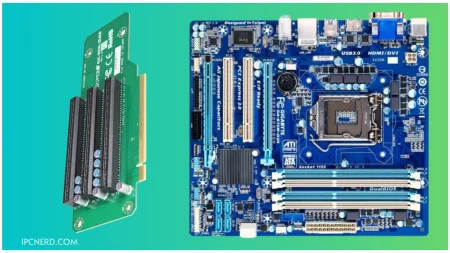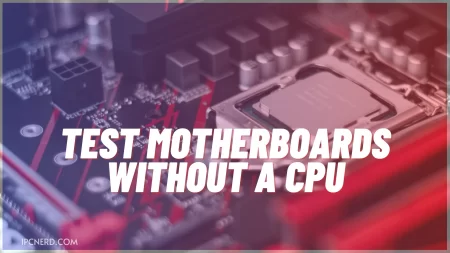When you’re building a computer, there are many things to consider – your budget, the type of computer you want to build, and what components will work best with your needs.
But one thing you might not think about until after the machine has been assembled is fan direction. This blog article will discuss what it means for your CPU cooler fan and how it should be oriented.
- Why is the CPU cooler fan direction important?
- How to Find the Right Fan Direction for Your CPU Cooler
- What are the different types of CPU cooler fan directions?
- Purpose of a CPU Cooler Fan
- Most Common CPU Cooler Fan Directions
- How can you tell if your CPU fan is facing up or down?
- Benefits of Proper CPU Cooler Fan Direction
- Frequently Asked Questions
- Conclusion
Why is the CPU cooler fan direction important?

When choosing the right CPU cooler fan direction, keeping a few things in mind is important. First, the fan should be pointing towards the heatsink or processor so that heat can be transferred more easily.
Additionally, if the fan is located behind the motherboard, airflow may be restricted, resulting in higher temperatures. Finally, ensure the fan is rotating at a consistent speed – too fast or too slow can lead to problems.
How to Find the Right Fan Direction for Your CPU Cooler
When it comes to choosing the right CPU cooler fan direction, it can be a little confusing. The most important thing to remember is that the fan should be directed toward the heat source – in other words, the processor. There are a few factors to consider when determining this:
- The orientation of your processor: Most CPUs are designed with one or more fans. If you have a tower or desktop PC, ensure the fan is facing down towards the processor so air can flow through it and dissipate the heat. If your PC has a liquid cooling system, orient the fan, so its blades are pointed at the radiator.
- The location of your heatsink and fans: Your heatsink will likely come with instructions on where to place the fans to best cool your processor. Follow these instructions closely if possible, as incorrect placement can result in poor performance.
- The size of your CPU cooler: Coolers come in different sizes and shapes, so make sure you choose one that will fit comfortably on your motherboard without being too tight or loose. Some coolers also come with mounting brackets that make installation much easier.
What are the different types of CPU cooler fan directions?
There are many different types of CPU cooler fan directions. The most common type is the “push” direction, where the fan blows air down onto the processor.
Another common type is the “pull” direction, where the fan blows air upward onto the processor. Some cooler fans have both push and pull directions, while others only have one direction.
Some people prefer a fan direction that pushes air outward instead of downward. Others prefer a fan direction that pulls air inward instead of upward. It depends on your individual needs and preferences. Ultimately, you’ll need to decide which fan direction is best for you.
Purpose of a CPU Cooler Fan
A CPU cooler fan circulates air around the processor to keep it cool. There are different directions that a fan can be directed depending on the type of CPU cooler you are using.
For example, a tower cooler may have a fan on top that blows air into the system, while a laptop may have a fan on the side that blows air directly onto the processor. It is important to know which direction the fan should be directed for it to work properly.
Most Common CPU Cooler Fan Directions
Fans on CPU coolers can be directed in various ways, but the most common directions are toward the processor and heat sink. Many opt for a fan pointing directly at the processor to help move air over it more efficiently. Some fans also have fins that direct airflow toward the heat sink.
How can you tell if your CPU fan is facing up or down?
There are a few ways to determine if your CPU fan is facing up or down. One way is to look at the blade on the fan. If it’s facing down, the fan will be pulling air in from underneath the computer.
The fan will push air out of the computer if it’s facing up. Another way to tell is by looking at the direction of the fins on the fan. If they’re pointing down, it’s facing down. If they’re pointing up, it’s facing up.
Benefits of Proper CPU Cooler Fan Direction
There are many benefits to ensuring that your CPU cooler’s fan is directed correctly. Proper fan direction can help improve airflow, provide better cooling, and even reduce noise levels. Here are four reasons why you should orient your CPU cooler fan in the correct direction:
1. Air Flow. When your CPU cooler’s fan is oriented incorrectly, it can cause a bottleneck in the system’s airflow. This can lead to overheating and decreased performance.
2. Cooling Efficiency. Oscillating fans work best when they move a large volume of air simultaneously. If your cooling fan is not oriented properly, it may only be able to move a small amount of air at a time, resulting in less effective cooling.
3. Noise Levels. Incorrectly orientated fans can produce high amounts of noise when they spin around their axes. This noise can become bothersome and disruptive over time, especially if it’s located near where you’re working or sleeping.
4. Comfort & Safety. Poorly oriented fans can also create dangerous conditions by kicking up particles and debris that could enter your eyes or lungs while you work or sleep. You can avoid these risks by orienting your CPU cooler’s fan in the correct direction and enjoying consistent quality cooling throughout all seasons.
Frequently Asked Questions
What is the proper CPU cooler fan direction?
There are generally two ways to orient a CPU cooler fan: perpendicular to the motherboard and parallel to it. The first is preferable because it creates a more even flow of air across the chip, providing better cooling. However, some enthusiasts argue that fans should be oriented parallel to the motherboard for added stability. Ultimately, it’s up to you which way you prefer.
How can I clean my computer’s fans?
Fans can be cleaned using a vacuum cleaner and a small brush.
Conclusion
There are a few things to remember regarding the CPU cooler fan direction. For starters, ensure the fan is facing the cooler’s heat sink (or the chipset if your CPU has one).
Orient the fan so air flows perpendicular to the motherboard’s processor socket and toward the rear of the PC case. Finally, aim the fan, so its blades blow air directly onto your graphics card and next-closest expansion card.
Doing these three things should drastically reduce noise levels and improve airflow—two key factors in achieving optimal system performance.







